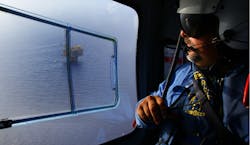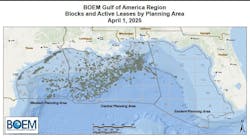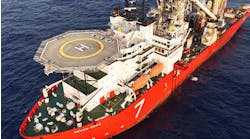‘Leaving it better than we found it’: BSEE Director looks back on his tenure
Offshore staff
Social license and environmental protection are driving policy and political considerations in today’s offshore arena. These considerations conform to the remit of the Bureau of Safety and Environmental Enforcement (BSEE), which is to promote safety, protect the environment, and conserve offshore resources.
Scott Angelle has served as director of BSEE since May 2017, and during his tenure the agency has introduced regulations designed to improve offshore drilling and production systems; increase production while improving safety; and create new online tools to better communicate with the offshore industry.
In addition, over the past year, the agency, along with the industry, has had the added responsibility for preventing the spread of the coronavirus into the offshore workplace. Angelle spoke with Offshore in January 2021 to provide an update on these issues, just as a new presidential administration was coming into Washington, DC.
***
Offshore: The COVID-19 pandemic been with us close to a year now. How would you assess BSEE’s efforts to prevent the spread of the virus among offshore workers?
Angelle: I would give high marks to both industry and BSEE for their efforts to contain the virus. At BSEE, we have a duty and a responsibility to inspect every facility once a year, and inspect drilling operations every 30 to 45 days. I should mention that the companies that own the rigs and platforms have the right to create their own protocols. And we at BSEE have the right and responsibility to establish our own protocols.
From mid-March 2020 through late December 2020, we conducted almost 2,800 inspections. We visited 1,258 Gulf of Mexico facilities. We also did some virtual inspections of Gulf facilities, and we did that in the Pacific as well. And we did not in that time have a single BSEE inspector test positive for COVID-19 as a result of traveling to the outer continental shelf. The protocols played a tremendous role in this, as did our ability conduct virtual inspections.
Offshore: What are your key metrics for assessing industrial safety and environmental protection?
Angelle: The first thing I would mention is air quality. The key issue here is the flaring and venting of gas. The industry has consistently achieved a ratio of less than 1.25% of flared, vented gas to produced gas. That makes the offshore province of America one of the best performing oil and gas-producing provinces in the United States. And there’s a reason for that, most notably the phenomenal pipeline system that we have offshore. That excellent pipeline system allows BSEE to have stringent regulations that we enforce. If you compare every other major producing province in America, I think you’ll find that the US offshore arena is one of the best, if not the best, in this respect.
Another key metric is how we treat and respect marine life. I’m happy to say that we have had no incidental marine mammal or sea turtle fatalities from OCS exploration and production since at least 2017. We know that America has a high expectation that the industry respects marine life, and to coexist peacefully with that marine life. And those are values that I’ve held all my life, because my home state of Louisiana places a great deal of importance on the value of fisheries and marine life.
Another key metric is the amount of oil in the water. When you look at the amount of oil released in E&P operations in 2018 and 2019 on the OCS, it’s the lowest amount in 25 years or more. And as important as that metric is, it’s also important to note that we achieved this in the midst of record production. In 2018, we had the highest amount of oil production to date in the history of OCS production, and we topped that figure in 2019. Typically, when production volumes go up, you put yourself in a position to have more spills. But the opposite of this happened. The ratio of volume spilled to volume produced in 2018 was an equivalent ratio of 13 tablespoons in a 660,000 gallon Olympic-sized swimming pool. That’s the volume spilled to produced. And when you take a look at in 2019, that was 17 tablespoons in that 660.000-gallon Olympic sized pool. We’re very proud of those numbers. And again: look at how far we have come since 2010.
Offshore: Before you became director, the US Government Accountability Office (GAO) had placed BSEE on a “high risk” list, a designation for agencies that need significant organizational improvement. What has BSEE done to improve its processes and work toward removal from the list?
Angelle: When I came in in May 2017, I was handed a report that indicated that GAO had elevated BSEE on its high-risk list. That’s kind of a daunting starting point when you’ve just taken office. It has taken a considerable amount of hard work to address those concerns and get them fixed.
The GAO issues this report every two years. So in February 2019 they acknowledged our progress by indicating that more time was needed to institutionalize the improvements. We continued to work hard, collaborate, and engage. We had to call upon everyone’s sense of pride and sense of duty to move this forward. And we have continued to plow through some 800-plus number of change of management initiatives since then.
I remain hopeful while confident that GAO is going to fairly evaluate the improvements that we have made. And I remain hopeful that when their new report comes out, that they do in fact recognize BSEE’s tremendous turnaround. And I’m hopeful that BSEE will be deemed worthy of getting off of that negative, unflattering list.
Offshore: In May 2019, BSEE revised its well control rule. How is the industry faring with its compliance with the revised rule?
Angelle: I think it’s important to understand that when we revised the rule in 2019, we didn’t take a chainsaw to it. We took a scalpel. The instructions to revise the rule were to look for and reduce overly burdensome regulations, and make things more efficient without reducing safety. And even after we had revised the rule, some 80% of the rule remained intact. So the 2019 rule is a lot like the 2016 rule. Overall, we revised 53 provisions, while 258 provisions remained unchanged. And in so doing, we made the rules safer.
For example, one of the things that we changed was the frequency of BOP testing. The 2016 rule required BOP testing every 14 days, although every other offshore region in the world used a 21-day testing interval. We looked at the data that we were getting from operators, and it was clear that we had been over-testing this equipment. And the danger is, when you over-use something, it may not be there for you when you need it. That conclusion was affirmed by the Argonne National Laboratory, which examines testing frequencies. So we decided that a 21-day testing frequency has a lower probability for failure than a 14 day testing frequency. We were very specific on how we changed this rule, and we haven’t had a blowout under this new rule. So not only did we reduce the regulatory burden on the industry; we also improved safety in the process.
Offshore: Last fall, BSEE issued an Arctic Exploratory Proposed Rule with regard to Arctic drilling. Can you provide an update?
Angelle: As with the well control rule, we were instructed to look at the 2016 rule that was previously promulgated and determine if there are any overly burdensome regulations that could be removed without sacrificing safety or environmental safeguards.
We went through a rulemaking procedure, in consultation with Alaskan native tribes, and then published a draft rule. The public comment period opened on Dec. 9, 2020, and we are going to be taking public comments up through Feb. 8, 2021. And then according to the rulemaking protocols, BSEE will have to review all the comments for recommended changes.
So nothing has actually been changed on this front; it’s just a draft rule at this point. The new administration will have to make some decisions on that. And again, we used a scalpel, not a chainsaw. Of the total 65 provisions in the rule, we determined that 21 were appropriate for revision. So two-thirds of the regulations in this rule are unchanged. We added 13 provisions to maintain safety and environmental protection there in Alaska. So the rule is not final, and the new administration will have some decisions to make.
Offshore: Speaking of which – with the advent of a new administration, do you see BSEE’s role changing?
Angelle: No, because the agency’s role is to regulate safety and environmental protection on the OCS. Every administration has a right to govern in a way that they wish, and I certainly respect that. But I would also make the case that if you want to reduce emissions, the offshore arena is better. If you want to be safe, offshore has shown that it is the second-best performing high hazard industry in the country, only second to nuclear energy. If you want to talk about spills, take a look at that data. That data suggests that active E&P operations on federal offshore leases are having their best performance in more than a quarter of a century. There is this conversation going on in America that says: “While you make your economic decisions, we as a country are saying you need to be mindful more than ever of your environmental considerations.”
But the point I am trying to make here is: 10 years after the worst environmental disaster in US history, the Gulf of Mexico is now the most environmentally advantaged oil-producing province in the country. There are so many advantages to American offshore energy. From a safety and environmental standpoint. The way we treat marine life; the growing amount of energy production; the royalties that go to the federal treasury; and the royalties that did fund the Great American Outdoors Act. All of that really is a great story.
It seems evident that environmental considerations are going to play an even larger role in our energy policy and energy production in the future. And I’m here to tell you that the Gulf of Mexico welcomes that opportunity, because the performance and the turnaround program there has been incredible.
My hope is that BSEE continues to improve its performance in preserving the offshore environment and protecting the people who work there. But at the same time, I’m hopeful that our country will embrace the facts. And the facts are that is that the US offshore arena is a very environmentally advantaged province for the country.



